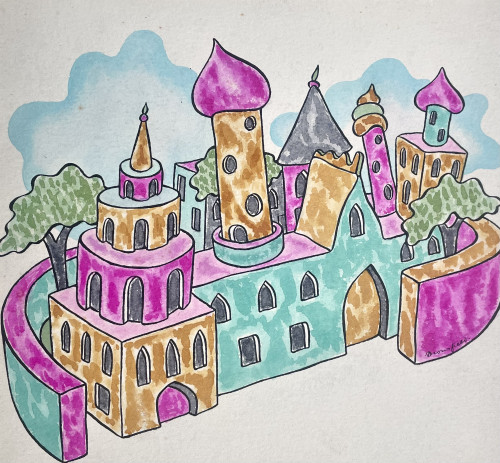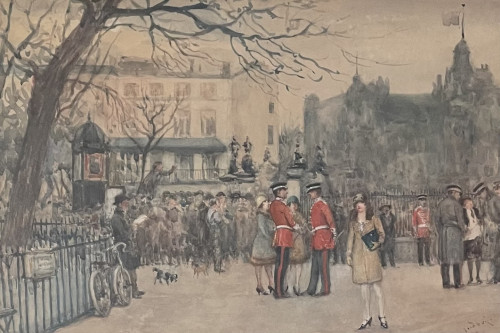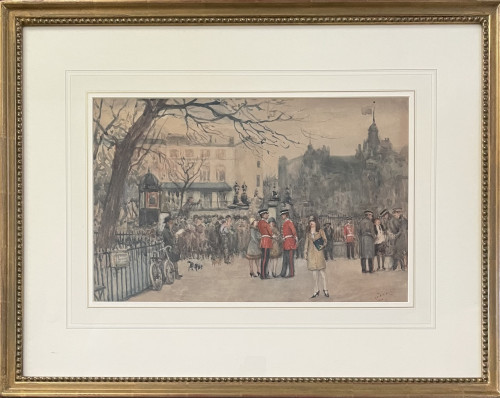The Last Chelsea Regatta, 1871
The Last Chelsea Regatta, 1871
Greaves was the son of a Chelsea boat-builder and waterman. He and his brother Henry initially trained as shipwrights but in their spare time drew and painted local views of the Thames and the streets and lanes of Chelsea. In the early 1860s they met Whistler who was to become a close friend and mentor. They took Whistler on the river, acted as studio assistants and became his pupils. The relationship with Whistler lasted until the early 1880s when the irascible master fell out with his hero-worshiping disciples. Walter continued to paint and draw views of the Thames and Chelsea. As with Whistler’s etchings, these were often retrospective views showing the area before the building of the Embankment in the early 1870s, when vast areas of the old waterfront were demolished. Confusion often arises over the dates that appear on his works, as they indicate the date of the retrospective view rather than the date of execution. Much of his life was spent in poverty and in 1922 he was admitted to the Charterhouse as a Poor Brother, where he remained until his death. “The regatta of 1871 was the wake of old Chelsea village. Less elaborate than it once had been, it was still the event of the year and the prizes for the rowing race between the Royal Hospital and Cremorne ”“ a purse of sovereigns was first prize ”“ were subscribed by the citizens of Chelsea. But now, at last, the old waterfront was to go and the granite embankment was to advance westward from the Royal Hospital to Battersea Bridge. This year the narrow streets and taverns were more crowded than usual and Walter and Henry Greaves looked hungrily at the scene, determined to print it vividly on their memories. In this they succeeded and, many years later, Walter remember that “what with guns firing, flags flying, bands playing and the immense crowd of people, Chelsea was pretty lively ”¦ This regatta, like the other river races made a remarkably artistic display of colour especially as it took place on a fine summer’s day, with blue skies and white clouds. The Adam and Eve, the headquarters of the sports, was crammed with people and one wondered how it stood the strain of such weight, being a very old building. The Old Church entered into the gaiety, flying the white ensign from the top of its tower, and from the windows of the other old buildings, people would be urging on their favourite rowers, whilst crowds would run along the shore and cheer them along. The umpire accompanied the race in a four-oared boat rowed by four watermen. The Duck Hunt, which ended the day’s sport was a man in a small dinghy being chased by two larger boats and eventually caught, causing considerable amusement amongst the onlookers, who afterwards adjourned to the various inns for refreshment and song-singing. Of course, the Old Battersea Bridge had its share of the crowd, and likewise the steamboat pier, which put the finishing touches to the scene.” Walter Greaves watched the final race from the Chelsea end of the old bridge, looking down on to the crowded beach ”“ the race was rowed at slack low-water ”“ and to the three crowded, flag-fluttering balconies of The Adam and Eve. He later painted this scene in oils and produced the largest and most lively of the etchings he was making under tuition from Whistler. Again it is a highly original and distinctive work, owing nothing to The Master. The design is bold, making dramatic use of the dark upright timber piles of the steamboat pier in the foreground. The little figures in his crowd have come to life as they did on Hammersmith Bridge and the picture catches and preserves a vigorous, happy moment. The last prizes presented, the last song sung, the demolition gangs moved in.” (Tom Pocock, Chelsea Reach, London 1970, pp.89-90.) An impression of this plate was exhibited at the Goupil Gallery, Walter Greaves exhibition, 1922, no.7. There is an oil painting of the same subject in the collection of Manchester City Art Gallery and the British Museum hold an impression of this etching.
Dimensions:
RELATED ITEMS



















